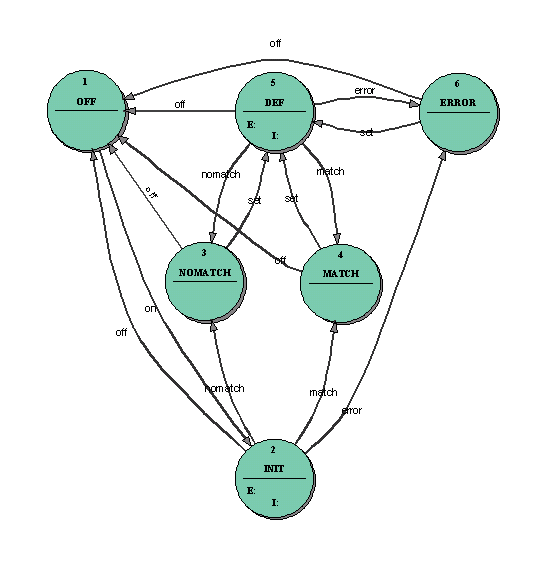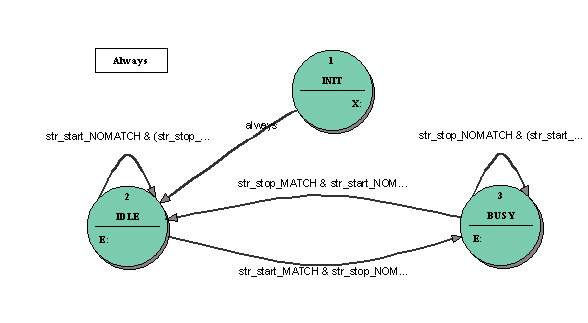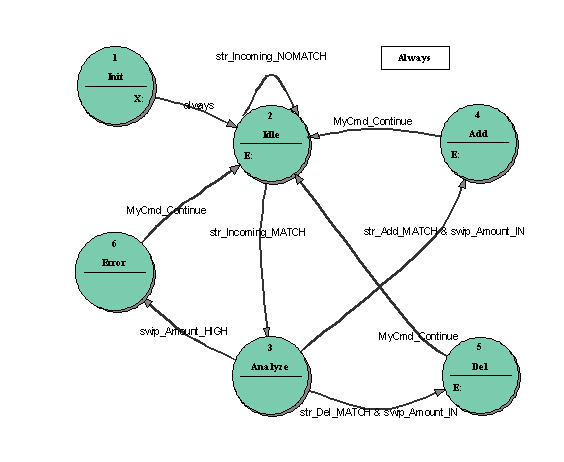T. Wagner October 2003
StateWORKS: String Object (STR)
Introduction
In contrast to typical digital and analogue signals in industrial control, in some systems, such as telecommunication and internet applications the control information has to be extracted from a string. For instance it might be required to check if in a dialled phone number the international prefix '00' is provided, or when extracting an XML message the value of an attribute will be evaluated. Also simple 'understanding' of an incoming word like 'start' might be useful.
The STR object offers all possible flexibility. It can be set up to exactly match the incoming strings, or to extract matching sub strings and provide them to other objects (other STR or a SWIP for converted values) for further evaluation. The functionality is provided by the regular expressions as known in UNIX tools like sed.
Regular Expression
A regular expression (RE) is a notation used for string evaluation. To fulfil various format requirements the RE defines a set of characters as listed in Table 1 below1.
| RE | Meaning | Example |
| . | Matches one arbitrary character | a.c matches 'abc' but not 'abbc' |
| ^ | Matches the beginning of a string | ^ab matches 'abcd' but not 'cdab' |
| $ | Matches the end of a string | ab$ matches 'cdab' but not 'abcd' |
| \n | n=1..9, matches the same string of characters as was matched by a sub expression enclosed between () preceding the \n. n specifies the n-th sub expression | (ab(cd)ef)A\2 matches 'abcdefAcd' |
| ( ) | sub expression | (\d)A(\d) matches 1A2, 0A4 ... |
| [ ] | Defines a set of characters to be matched | [a-z] matches 's', 'w'… but not 'S', 'W'… |
| [^ ] | Defines all characters except the Characters in the set | [^1-9] matches 's', 'W' … but not '1', '2'… |
| ( | | ) | Matches one of the alternatives | (ab|cd) matches 'ab' and 'cd' |
| RE+ | Matches one or more times the RE | [^1-9]+ matches 'Good' but not 'Obj5' |
| RE? | Matches one or zero times the RE | abc? matches 'ab' and 'abc' |
| RE* | Matches zero or more times the RE | ab* matches 'a', 'ab', 'abb' … |
| RE{n} | Matches exactly n times the RE | ab{2} matches 'abb' only |
| RE{n,} | Matches at least n times the RE | ab{2,} matches 'abb', 'abbb' but not 'ab' |
| RE{n,m} | Matches any number of occurrences between n and m inclusive | ab{1,2} matches 'ab' and 'abb' only |
Table 1: Special characters used with RE
Examples:
- to find leading '00' substring in a phone number following RE could be used: ^(0){2}
- to evaluate the numeric value of the attribute 'type' of an XML tag following RE could be used: type="([0-9]+)"
- to check if the incoming string is 'start', the RE would be(start)
Object Description
The STR object is itself a Virtual Finite State machine (VFSM). Its state transition diagram is shown in Figure 1. There are three commands defined:
on - activate the STR object
off - deactivate the STR object
set - reactivate the STR object
After the RTDB is started, the STR VFSM is in state OFF. When receiving command 'on' it goes to state INIT. In the INIT state the VFSM watches the string parameter which will deliver the control information to evaluate. When this string parameter changes, the STR VFSM is triggered and analyses the incoming string using the regular expression. Depending on the analysis result the STR VFSM changes then to one of the states: MATCH, NOMATCH or ERROR and stays there until the command 'set' is received. When receiving command 'off', the STR VFSM goes to state OFF independently of the state in which it was before.

The STR object uses several properties:
Input - Specifies the data object containing the string to be evaluated
Regular expression - the RE can be hard coded or read from an data object
List of substrings - list of data objects which will receive the found substrings for further evaluation. This field can contain data objects of various data types. If a substring will be a number it can be written to a data object with a proper data type and evaluated then using a SWIP object. If a substring will be just a string, it can be evaluated by another STR object after the extraction. The Figure 2 below shows the property window of the STR object:

Figure 2. STR Object Properties
Examples
Two examples will be discussed here:
- Controlling of a VFSM by a string command:
This example shows how to evaluate incoming strings as pure commands
- Evaluation of substrings for control purposes
This example shows how to extract substrings from the received string and convert them to other data types for further evaluation.
Example1: Controlling of a VFSM by a string command
The following state machine is very theoretical and uses mainly two states: IDLE and BUSY. It goes to state BUSY when receiving a string containing the string "start" and returns to state IDLE when receiving a string containing the substring "stop". It ignores any other incoming strings. Figure 3 shows the VFSM.

The used objects are (in the object Id dictionary):
| Name | Object Type | Description |
| MyCmd | CMD-IN | Command for control purposes. |
| par_command | PAR | Object containing the command string |
| str_start | STR | Start command string definition. RE=(start) |
| str_stop | STR | Start command string definition. RE=(stop) |
The input names used in the VFSM are:
| Name | I/O Object ID | Description |
| always | Input name always existing | |
| MyCmd_Set | MyCmd | Command to reset the STR objects |
| str_start_MATCH | str_start | Input name generated when the par_Command object data value is 'start' |
| str_start_NOMATCH | str_start | Input name generated when the par_Command object data value is other then 'start' |
| str_stop_MATCH | str_stop | Input name generated when the par_Command object data value is 'stop' |
| str_stop_NOMATCH | str_stop | Input name generated when the par_Command object data value is other then 'stop' |
The output names used in the VFSM are:
| Name | I/O Object ID | Description |
| 1 MyCmd_Clear | MyCmd | Clears MyCmd |
| 2 str_start_On | str_start | Switches the str_start object on |
| 3 str_start_Set | str_start | Sends the 'Set' command to the str_start object |
| 4 str_stop_On | str_stop | Switches the str_stop object on |
| 5 str_stop_Set | str_stop | Sends the 'Set' command to the str_stop object |
To test this VFSM only the par_command has to be changed. With MyCmd_Set the used STR objects can be reset in case it is in the ERROR state due to a wrong regular expression.This example is implemented in project StrCmd.prj.
Example2: Evaluation of substrings for control purposes
The following state machine controls incoming requests to add or remove money to/from an account. It does not allow operations with amounts higher then 20,-EUR
The incoming request is a parameter in the following format:
**amount# - to add an amount
##amount# - to remove an amount
Hence, '**' string means the 'add' operation, '##' string means the 'delete' operation. The amount can be a number between 0 and 20. Single '#' marks the end of the request string.
The state machine as shown in Figure 4 fulfils the entire required functionality, but without real database access where the amounts would be calculated.

The used objects are (object ID dictionary):
| Name | Object Type | Description |
| MyCmd | CMD-IN | Command for control purposes; can be used for instance by a master VFSM |
| swip_Amount | SWIP | Object controlling the par_Amount object; will make sure that par_Amount does not exceed the defined limit |
| par_Amount | PAR | Object storing the amount as read from the par_Incoming object |
| par_Incoming | PAR | Object which receives the request from outside |
| par_Operation | PAR | Object storing the operation as read from the par_Incoming object |
| str_Add | STR | Add operation string definition. RE=(\*\*) |
| str_Del | STR | Delete operation string definition. RE=(\#\#) |
| str_Incoming | STR | Request string definition. RE=(\*\*|\#\#)([0-9]+)\# |
The input names used in the VFSM are:
| Name | Object ID | Description |
| always | Input name always existing | |
| MyCmd_Continue | MyCmd | Command to confirm that the VFSM could continue with next request |
| swip_Amount_HIGH | swip_Amount | Input name generated when the par_Amount object data value exceeds the limit |
| swip_Amount_IN | swip_Amount | Input name generated when the par_Amount object data value is below the limit |
| par_Operation_CHANGED | par_Operation | Input name generated when the par_Operation object received new data |
| str_Add_MATCH | str_Add | Input name generated when the par_Operation object data value is '**' |
| str_Del_MATCH | str_Del | Input name generated when the par_Amount object data value is '##' |
| str_Incoming_MATCH | str_Incoming | Input name generated when the par_Incoming object data value matches the regular expression |
| str_Incoming_NOMATCH | str_Incoming | Input name generated when the par_Incoming object data value does not match the regular expression |
The output names used by this VFSM are
| Name | I/O Object ID | Description |
| MyCmd_Clear | MyCmd | Clears MyCmd |
| swip_Amount_On | swip_Amount | Switches the swip_Amount object on |
| str_Add_On | str_Add | Switches the str_Add object on |
| str_Add_Set | str_Add | Sends the 'Set' command to the str_Add object |
| str_Del_On | str_Del | Switches the str_Del object on |
| str_Del_Set | str_Del | Sends the 'Set' command to the str_Del object |
| str_Incoming_On | str_Incoming | Switches the str_Incoming object on |
| str_Incoming_Set | str_Incoming | Sends the 'Set' command to the str_Incoming object |
To test this VFSM only the parameter par_Incoming has to be changed in the monitor. After each request evaluation the command MyCmd_Clear has to be sent to be able to proceed with the next operation.
This example is implemented in account.prj you can find in directory "Samples" after you installed StateWORKS Studio
1 Note, that there is no standard definition of a regular expression. Thus, you may see descriptions that deviate a little bit from the definition used here.

 download PDF version
download PDF version